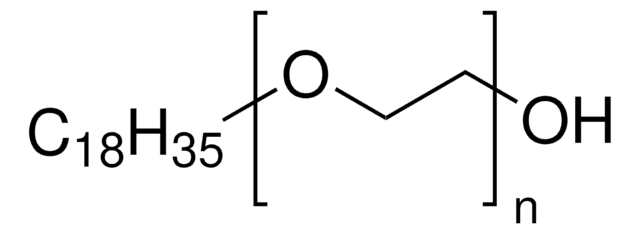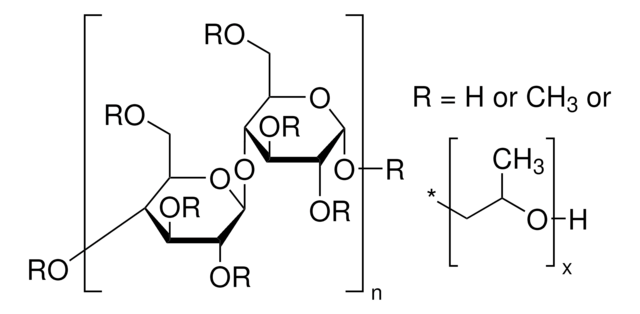Wichtige Dokumente
STS0213
ECO BRIJ® O10
Synonym(e):
Brij® O10, Brij® 97, C18-1E10, Polyoxyethylen-10-oleylether
About This Item
Empfohlene Produkte
Beschreibung
non-ionic
Qualitätsniveau
Form
semisolid
Mol-Gew.
~709 g/mol
Grünere Alternativprodukt-Eigenschaften
Use of Renewable Feedstocks
Design for Degradation
Learn more about the Principles of Green Chemistry.
sustainability
Greener Alternative Product
Verunreinigungen
≤3.0% water
mp (Schmelzpunkt)
25 °F
Säurezahl
≤1.0 mg KOH/g
Hydroxylzahl
75‑95 mg KOH/g
Löslichkeit
water: 100 mg/mL, clear, colorless to faintly yellow
Dichte
1 g/mL at 25 °C (lit.)
HLB
12.4
Grünere Alternativprodukt-Kategorie
, Aligned
InChI
1S/C20H40O2/c1-2-3-4-5-6-7-8-9-10-11-12-13-14-15-16-17-19-22-20-18-21/h9-10,21H,2-8,11-20H2,1H3/b10-9-
InChIKey
KWVPFECTOKLOBL-KTKRTIGZSA-N
Suchen Sie nach ähnlichen Produkten? Aufrufen Leitfaden zum Produktvergleich
Allgemeine Beschreibung
Anwendung
Leistungsmerkmale und Vorteile
- 100 % Renewable
- 100 % Bio-based
- Certified to the USDA BioPreferred Program
- Lower carbon footprint than petrochemical-based versions
- High-purity chemical suitable for a wide variety of research applications
Physikalische Eigenschaften
Sonstige Hinweise
Rechtliche Hinweise
Signalwort
Warning
H-Sätze
Gefahreneinstufungen
Aquatic Chronic 2 - Skin Irrit. 2
Lagerklassenschlüssel
11 - Combustible Solids
WGK
WGK 1
Flammpunkt (°F)
>464.0 °F - Equilibrium method
Flammpunkt (°C)
> 240 °C - Equilibrium method
Hier finden Sie alle aktuellen Versionen:
Analysenzertifikate (COA)
Leider sind derzeit keine COAs für dieses Produkt online verfügbar.
Wenn Sie Hilfe benötigen, wenden Sie sich bitte an Kundensupport
Besitzen Sie dieses Produkt bereits?
In der Dokumentenbibliothek finden Sie die Dokumentation zu den Produkten, die Sie kürzlich erworben haben.
Unser Team von Wissenschaftlern verfügt über Erfahrung in allen Forschungsbereichen einschließlich Life Science, Materialwissenschaften, chemischer Synthese, Chromatographie, Analytik und vielen mehr..
Setzen Sie sich mit dem technischen Dienst in Verbindung.






